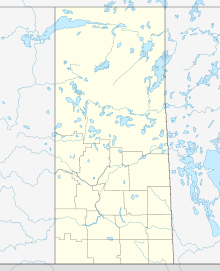| Location | |
|---|---|
| Location | Athabasca Basin |
| Province | Saskatchewan |
| Country | Canada |
| Coordinates | 57°45′40″N 105°03′06″W / 57.76111°N 105.05167°W |
| Production | |
| Products | Yellowcake (U3O8) |
| Production | 16.1×106 pounds (7.3×106 kg) |
| Financial year | 2017 |
| History | |
| Discovered | 1988 |
| Opened | 1999 |
| Active | 1999–2018 |
| Owner | |
| Company |
Cameco (70%) Orano Canada (30%) |
The McArthur River Uranium Mine, in northern Saskatchewan, Canada, is the world's largest high-grade uranium deposit.
The McArthur River deposit was discovered in 1988. The property is located 620 kilometres (390 mi) as the crow flies north of Saskatoon, Saskatchewan, and 80 kilometres (50 mi) northeast of the Key Lake mill in the uranium rich Athabasca Basin. Mine construction began in 1997, with production commencing in 1999. [1] The mine achieved full commercial production in November 2000. Production is regulated at 18.7×106 pounds (8.5×106 kg) of yellowcake a year with the ore being processed through the Key Lake mill.
Between 2000 and 2013, the McArthur River/Key Lake operation produced 250.6×106 pounds (1.137×108 kg) U3O8. [2] This production figure includes blended low grade stockpiles from the former Key Lake mine as well as ore derived from the McArthur River mine. Ignoring the fact that 2000 mostly saw a ramp-up to full scale production and the effect of the Key Lake mine ore, this averages to roughly 17.9×106 pounds (8.1×106 kg) yearly production or some 96% of the above-mentioned 18.7 million pound per year limit.
In 2012, McArthur River was the world's largest producing uranium mine, accounting for 13% of world mine production. [3] Canada, as a whole, produces 15% of the world's uranium production.
In July 2018, citing continued low uranium prices, Cameco suspended McArthur River/Key Lake operations and placed the mine on care and maintenance. [4] As of April 2020 [update], the mine remains under care and maintenance. [5] On February 9, 2022, Cameco announced it would reopen the mine. [6]
Reserves

As of December 31, 2017, the mine had Proven and Probable Reserves of 391.9×106 pounds (1.778×108 kg), with an average grade of 6.89% U3O8. [7] At an average yearly production rate of 16.1×106 pounds (7.3×106 kg) this gives a calculated range of roughly 24 years.
Awards
During the most hazardous mining operations, remote controlled underground mining systems in this mine [8] [9] are used to reduce personnel exposure to rock particulates, radon gas, and other hazards. [10] A video detailing the operations at the mine is provided by Cameco. [11]
The McArthur River mine has been awarded the Canadian Institute of Mining, Metallurgy and Petroleum's John T. Ryan Trophy for the best safety record for metal mines several times. This award is given to the metal mine with the best safety record for the previous year.
Ownership
The mine is owned by Cameco (70%), and Orano Canada (30%) (formerly Areva Resources Canada, formerly COGEMA Resources Inc.) Cameco is the mine operator.
Access
The mine is serviced by the McArthur River Airport to the northeast. It is also connected to the south by a restricted access haulage road. According to Google Maps, this road is Saskatchewan Highway 914, however the official 2011 highway map of Saskatchewan indicates that 914 terminates at a checkpoint at Key Lake mine, while the road that continues to McArthur is not a public highway (owned by Cameco) and does not appear on maps.
Scale
Given that much of the uranium recovered here goes to fuel CANDU reactors which can forgo uranium enrichment, it is possible to calculate a heating value for the uranium mined at this mine. At a typical burnup of 200 MWhthermal per kilo of heavy metal [12] The yearly production of roughly 16.1×106 pounds (7.3×106 kg) U3O8 is equivalent to roughly 6.2 kilotonnes (6,100 long tons; 6,800 short tons) of uranium metal and per the above burnup value some 4.46 exajoules (1.24×1012 kWh) (or the equivalent of 1.066 gigatonnes of TNT (4.46 EJ)) of thermal energy can be produced from this much uranium in CANDU type reactors. For comparison, the North Antelope Rochelle Mine, formerly the largest coal mine in the world, produces some 100 megatonnes (98,000,000 long tons; 110,000,000 short tons) of coal per year at a heating value of 8,800 British thermal units per pound (20,000 kJ/kg) for an overall heat content of roughly 2.047 exajoules (5.69×1011 kWh).
See also
References
- ^ Crossland, Ian, ed. (2012). Nuclear Fuel Cycle Science and Engineering. Oxford: Woodhead. p. 137. ISBN 9780857096388. Retrieved May 29, 2020.
- ^ "McArthur River - Summary". Cameco Corporation. Archived from the original on July 10, 2014. Retrieved June 9, 2014.
- ^ "World Uranium Mining". World Nuclear Association. July 2013. Archived from the original on June 13, 2014. Retrieved June 9, 2014.
- ^ "Cameco to suspend McArthur River and Key Lake". World Nuclear News. November 9, 2017. Retrieved March 16, 2018.
- ^ "Cameco puts Canadian uranium mine in safe shutdown amid pandemic". Mining Technology. London. April 9, 2020. Retrieved September 20, 2020.
- ^ "Cameco to restart production at McArthur River uranium mine". Mining Technology. February 14, 2022. Retrieved February 19, 2022.
- ^ "Cameco Uranium Operations › McArthur River/Key Lake". Cameco Corporation. December 31, 2020.
- ^ "Uranium: How is it Mined?". New Mexico Bureau of Geology & Mineral Resources. Retrieved March 28, 2024.
- ^ "The 10 biggest uranium mines in the world". November 3, 2013.
- ^ Jamieson, B.W. "Mining the high grade McArthur River uranium deposit - International.IAEA" (PDF). Retrieved September 18, 2020.
- ^ "Cameco McArthur River Virtual Tour". Retrieved March 28, 2024 – via www.youtube.com.
- ^ "CANDU In-Core Fuel-Management" (PDF). unene.ca. Retrieved March 28, 2024.
External links
- "McArthur River". Cameco Corporation. Archived from the original on July 10, 2014. Retrieved January 18, 2009.
- "McArthur River/Key Lake". AREVA.
